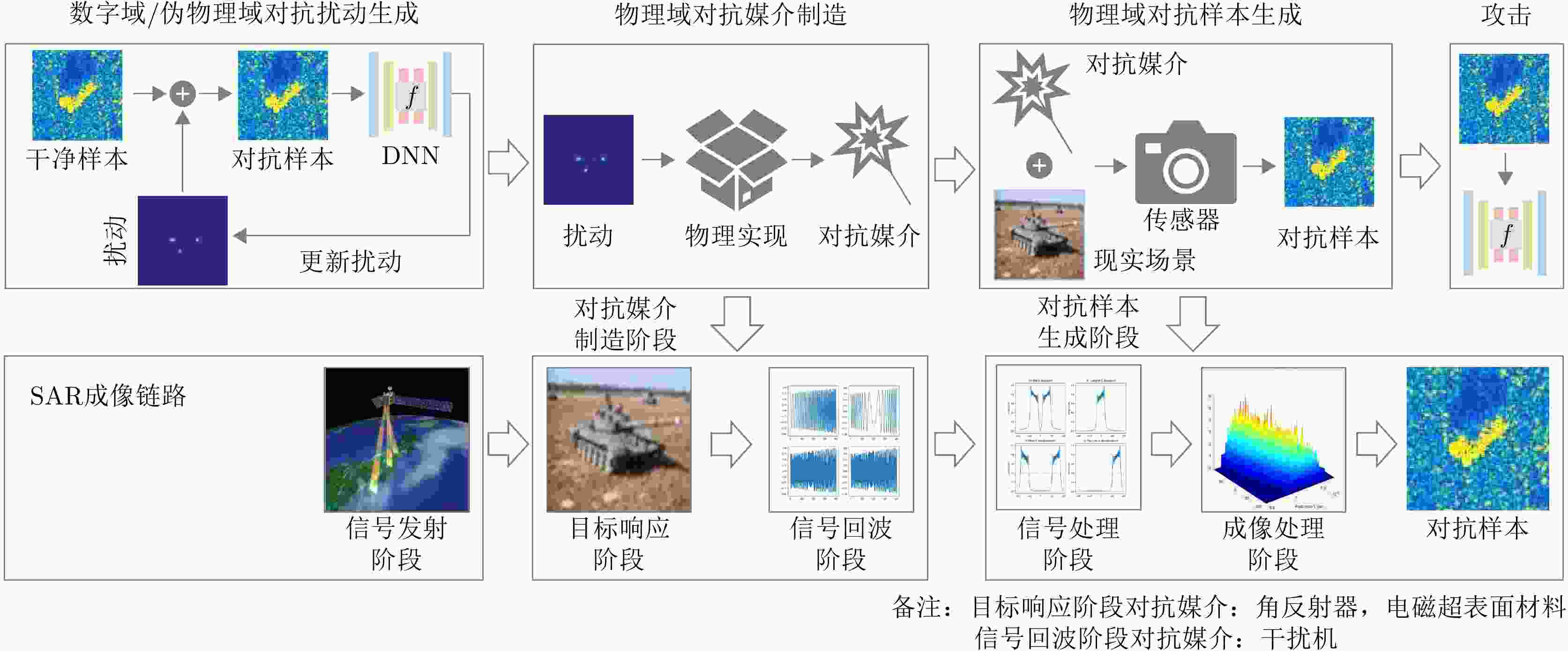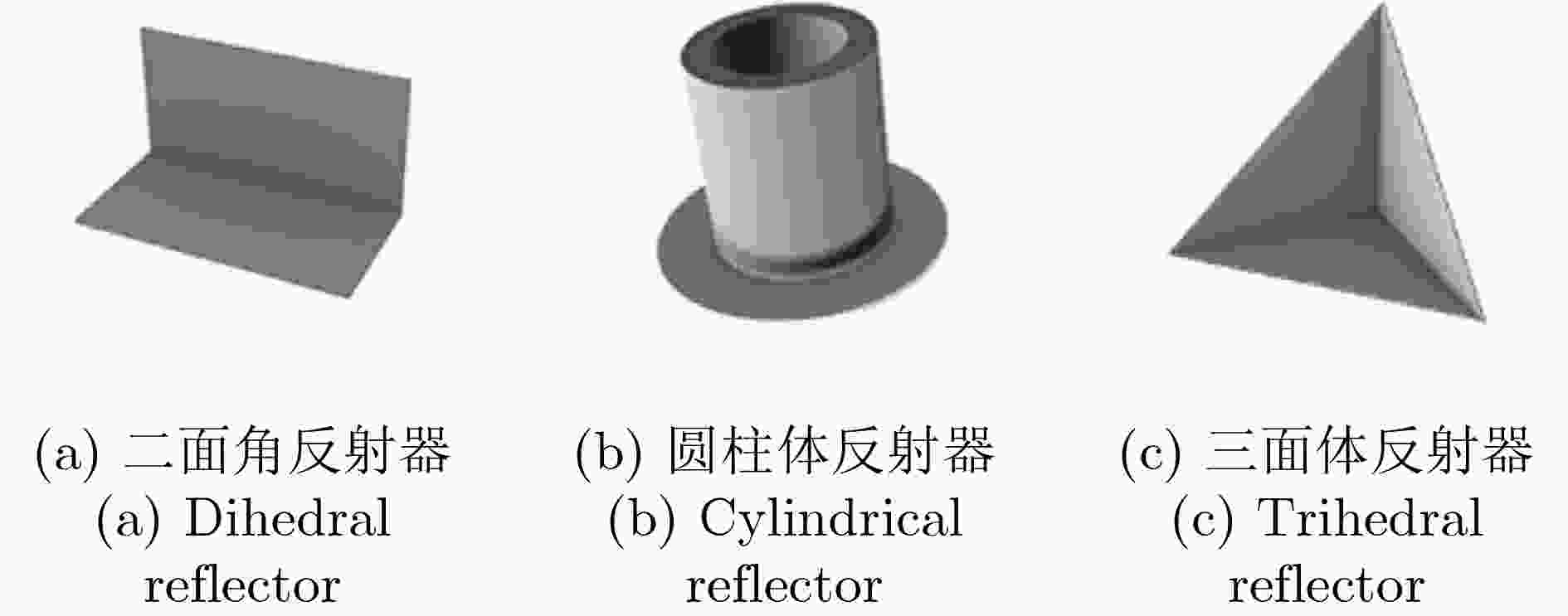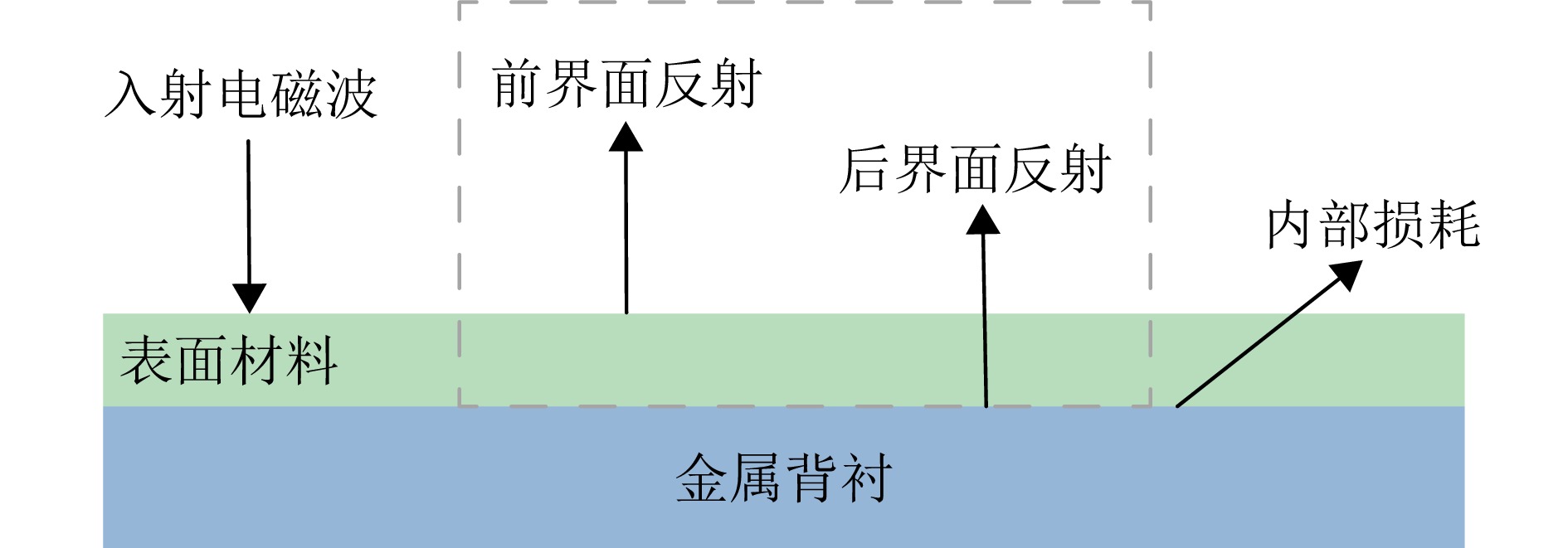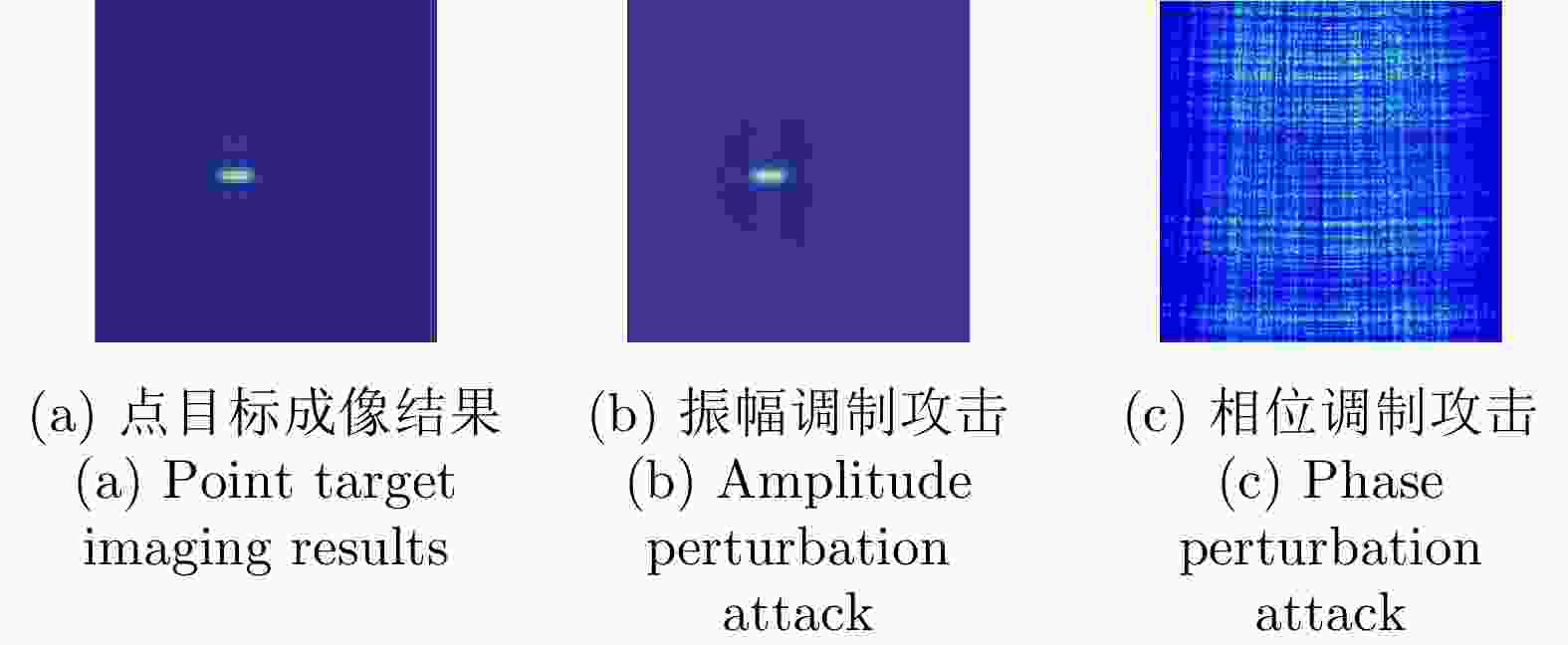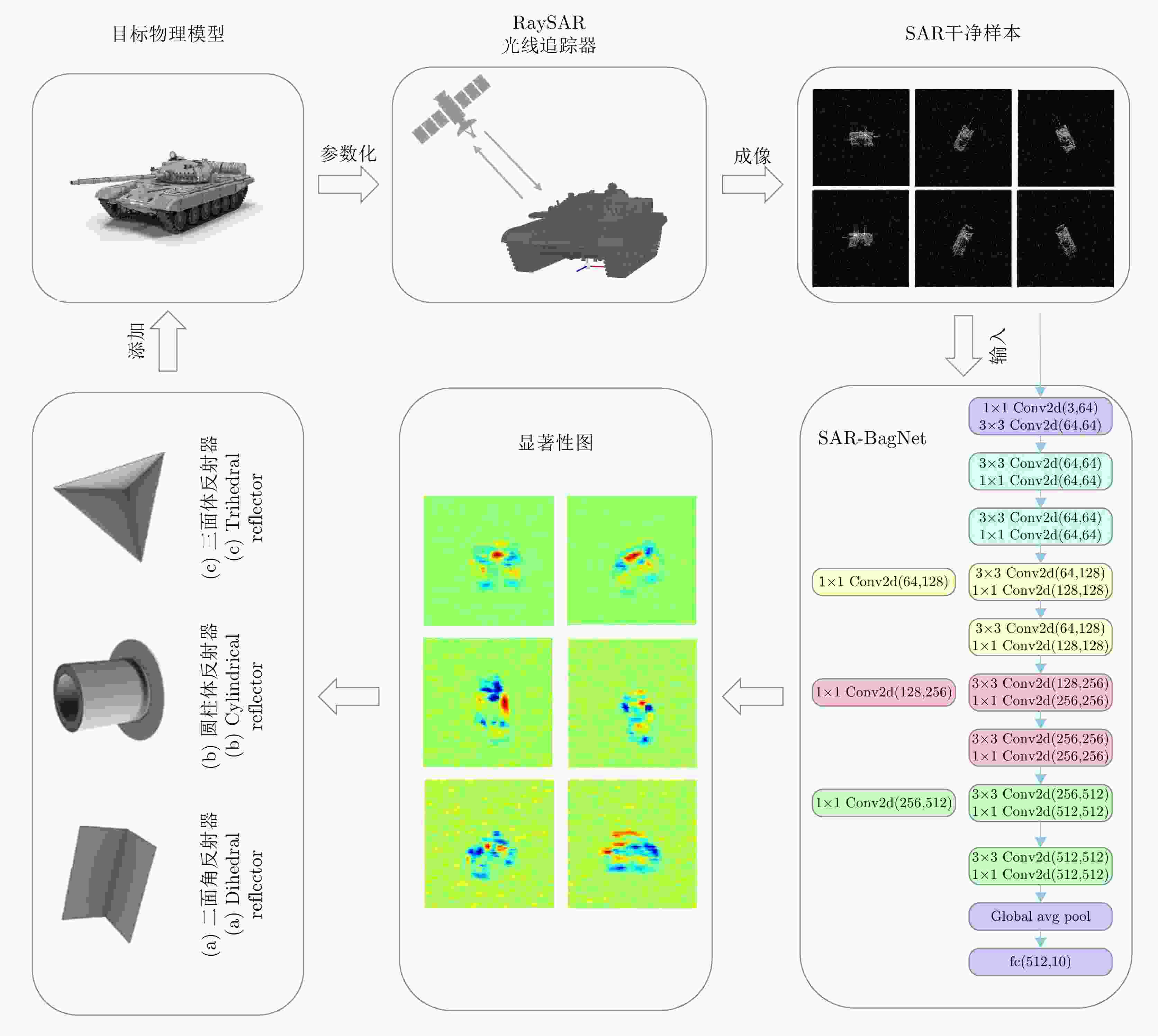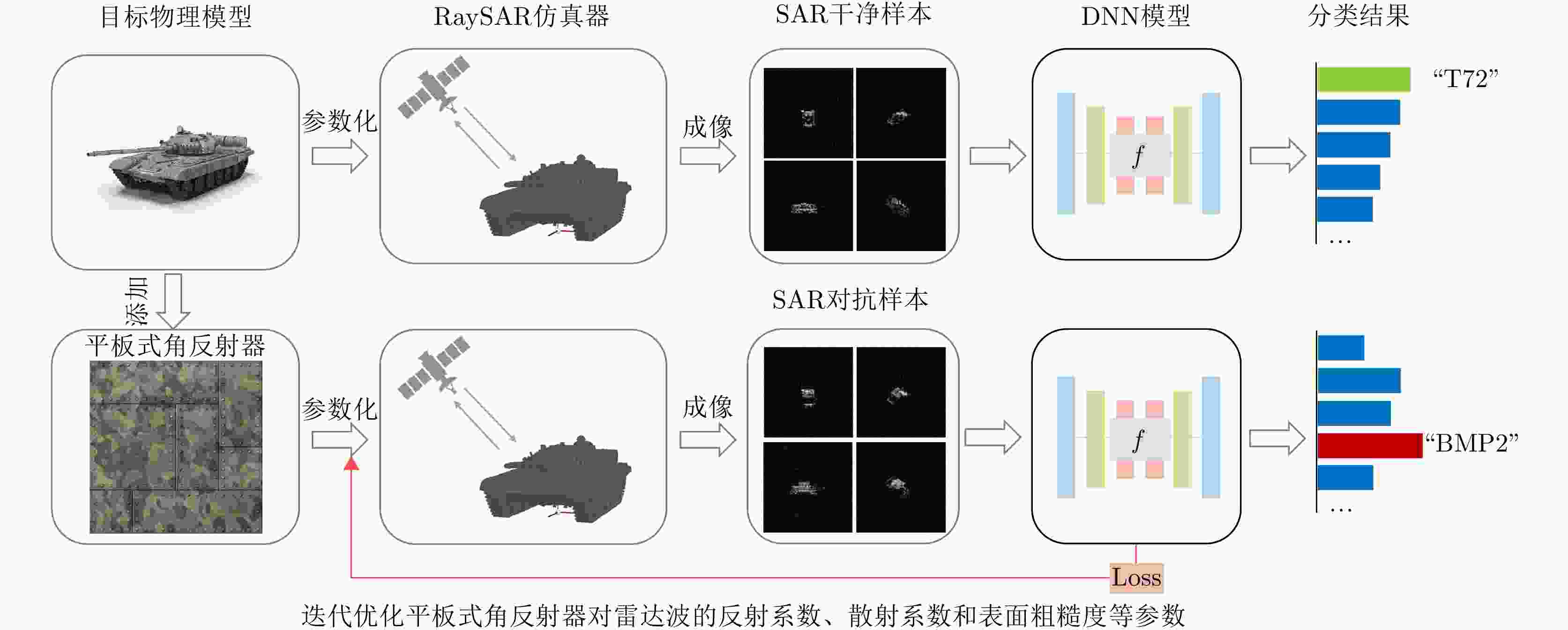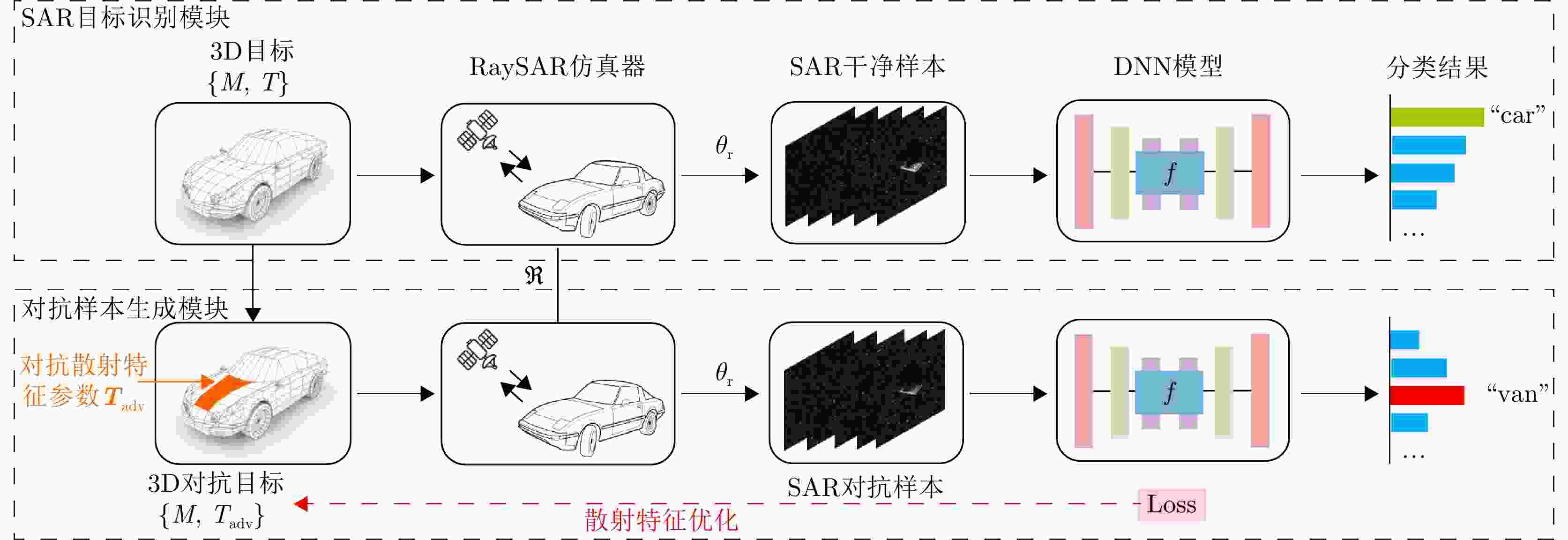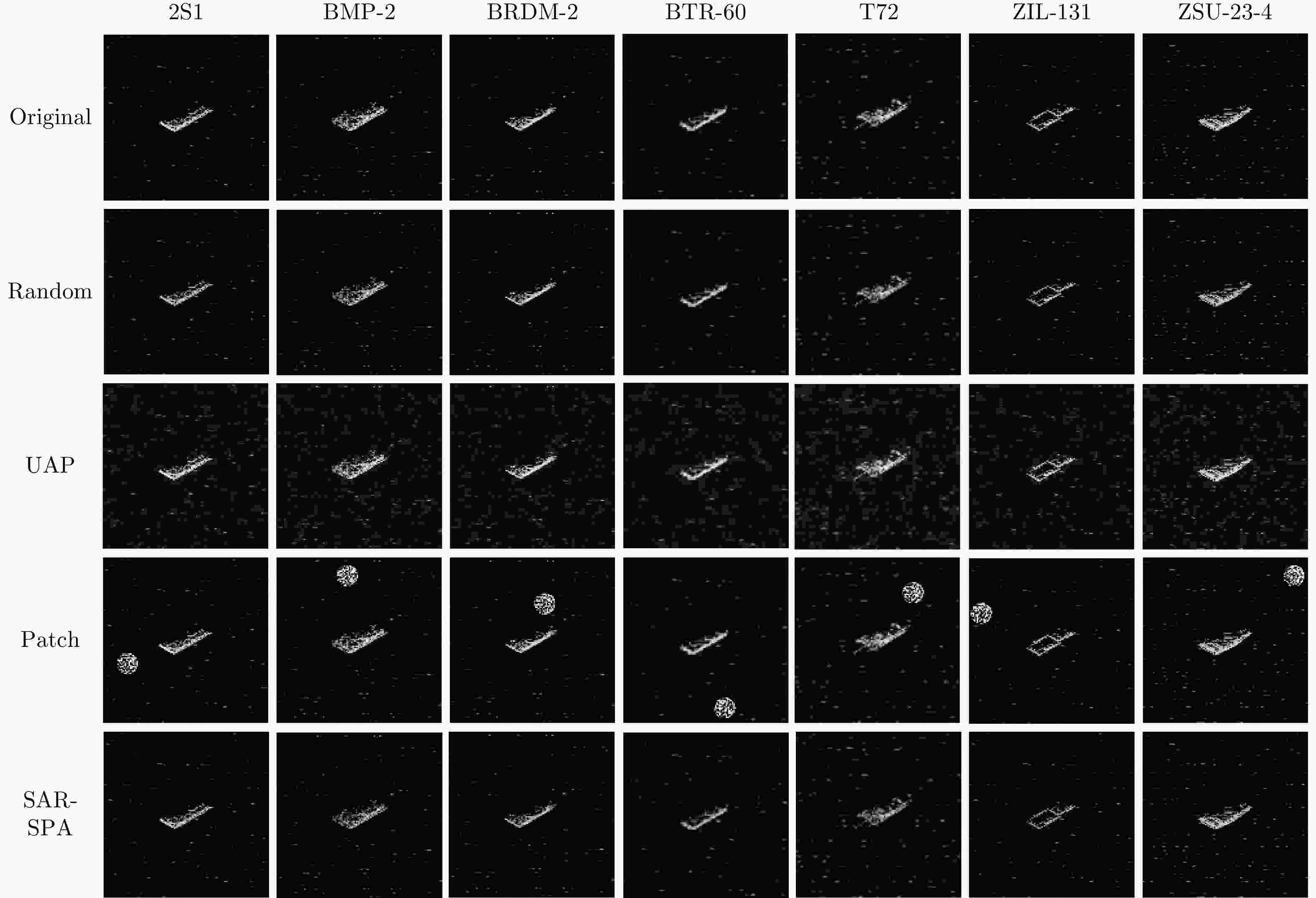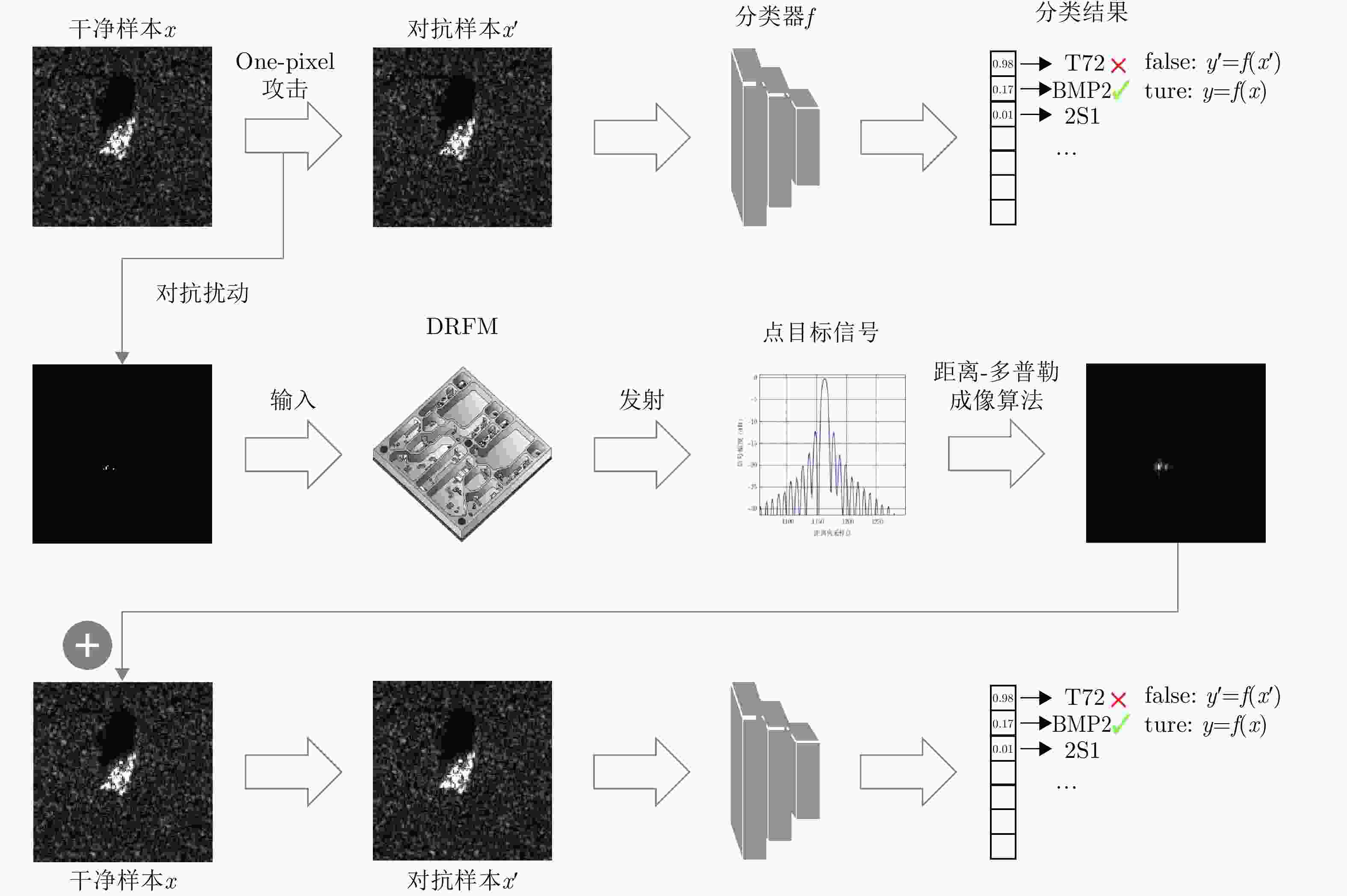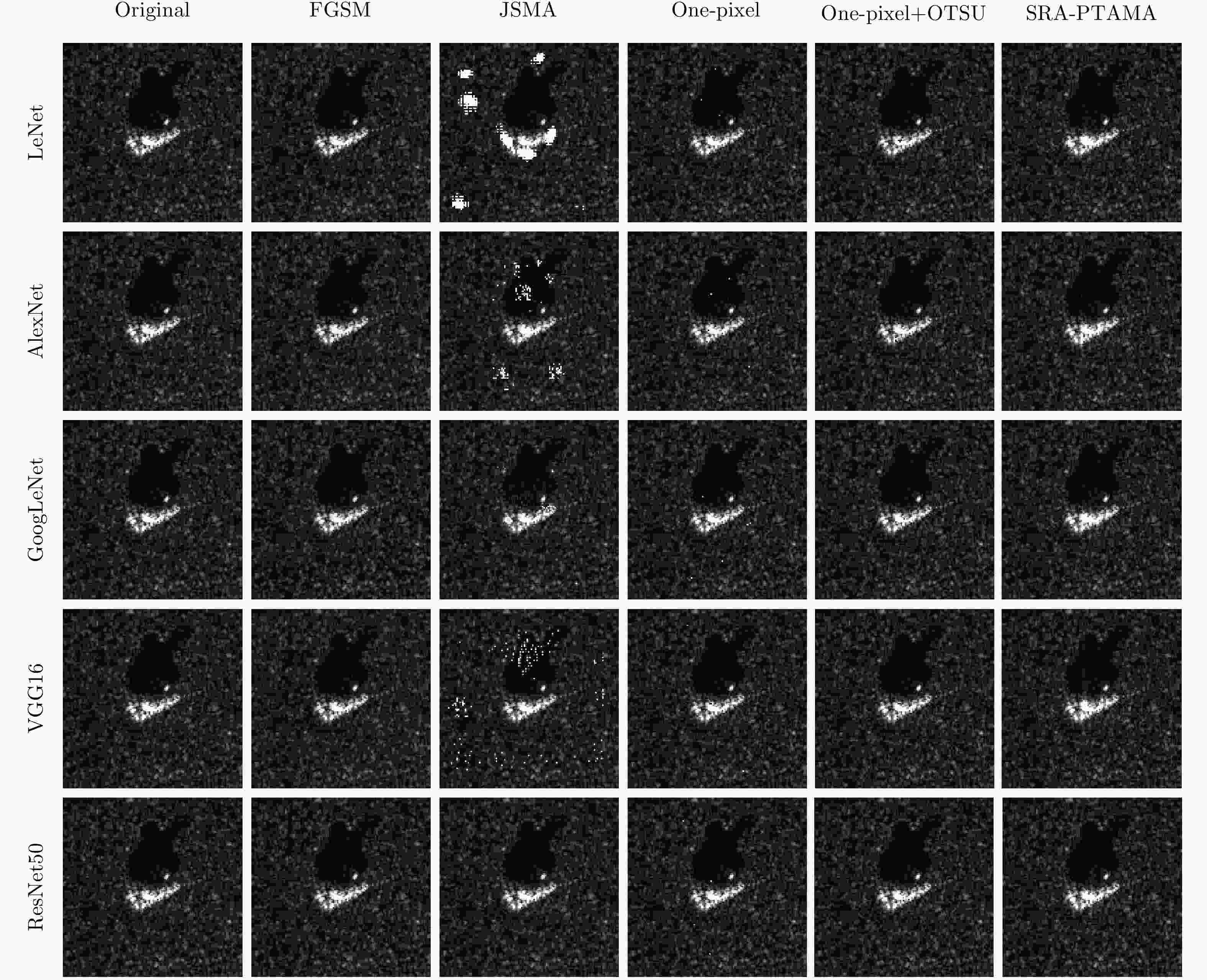A Survey of Adversarial Attacks on SAR Target Recognition: From Digital Domain to Physical Domain
-
摘要: 基于深度神经网络的合成孔径雷达(SAR)图像目标识别已成为SAR应用领域的研究热点和前沿方向。然而,有研究指出深度神经网络模型易受到对抗样本攻击。对抗样本定义为在数据集内故意引入微小扰动所产生的输入样本,这种扰动足以使模型高信度地产生错误判断。现有SAR对抗样本生成技术本质上仅作用于二维图像,即为数字域对抗样本。尽管近期有部分研究开始将SAR成像散射机理考虑用于对抗样本生成,但是仍然存在两个重要缺陷,一是仅在SAR图像上考虑成像散射机理,而没有将其置于SAR实际成像过程中进行考虑;二是在机制上无法实现三维物理域的攻击,即只实现了伪物理域对抗攻击。该文对SAR智能识别对抗攻击的技术现状和发展趋势进行了研究。首先,详细梳理了传统SAR图像对抗样本技术的发展脉络,并对各类技术的特点进行了对比分析,总结了现有技术存在的不足;其次,从SAR成像原理和实际过程出发,提出了物理域对抗攻击技术,通过调整目标物体的后向散射特性,或通过发射振幅和相位精细可调的干扰信号来实现对SAR智能识别算法对抗攻击的新思路,并展望了SAR对抗攻击在物理域下的具体实现方式;最后,进一步讨论了未来SAR智能对抗攻击技术的发展方向。
-
关键词:
- 对抗样本 /
- 合成孔径雷达(SAR) /
- SAR目标识别 /
- 物理域对抗攻击 /
- 深度神经网络(DNN)
Abstract: Deep Neural Network (DNN)-based Synthetic Aperture Radar (SAR) image target recognition has become a prominent area of interest in SAR applications. However, deep neural network models are vulnerable to adversarial example attacks. Adversarial examples are input samples that introduce minute perturbations within the dataset, causing the model to make highly confident yet incorrect judgments. Existing generation techniques of SAR adversarial examples fundamentally operate on two-dimensional images, which are classified as digital-domain adversarial examples. Although recent research has started to incorporate SAR imaging scattering mechanisms in adversarial example generation, two important flaws still remain: (1) imaging scattering mechanisms are only applied to SAR images without being integrated into the actual SAR imaging process, and (2) the mechanisms achieve only pseudo-physical-domain adversarial attacks, failing to realize true three-dimensional physical-domain adversarial attacks. This study investigates the current state and development trends in adversarial attacks on SAR intelligent target recognition. First, the development trajectory of traditional generation technologies of SAR-image adversarial examples is meticulously traced and a comparative analysis of various technologies is conducted, thus summarizing their deficiencies. Building on the principles and actual processes of SAR imaging, physical-domain adversarial attack techniques are then proposed. These techniques manipulate the target object’s backscattering properties or emit finely adjustable interference signals in amplitude and phase to counter SAR intelligent target recognition algorithms. The paper also envisions practical implementations of SAR adversarial attacks in the physical domain. Finally, this paper concludes by discussing the future directions of SAR intelligent adversarial attack technologies. -
表 1 数字域SAR图像对抗样本生成方法
Table 1. Digital domain SAR image adversarial example generation method
攻击方式 扰动范围 具体分类 攻击原理 方法代表 SAR灰度
图像攻击全局对抗扰动 基于梯度的攻击方法 利用目标识别模型的梯度信息生成对抗样本 FGSM[50−52]
BIM[56]
ILCM[57]
IMGS[59]
NAA[60]
PGD[62]
JSMA[50]基于优化的攻击方法 优化损失函数来生成对抗样本 C&W[7]
EAD[7]
Fast C&W[8]
One-pixel[50]
CRFA[68]基于边界的攻击方法 利用搜索等优化算法来生成对抗样本,
使其跨越目标识别模型决策边界DeepFool[7]
HJSA[7]
UAP[72,73]
DBA[9]
FDA[75]基于GAN的攻击方法 训练一个生成对抗网络(GAN)来生成对抗样本 AdvGAN[10]
Attack-UNet-GAN[11]
TAN[82]
TUAN[83]基于迁移的攻击方法 对目标模型的替理模型发起攻击,生成具有迁移性的对抗样本并成功攻击目标模型 SFA[85]
PFWA[86]
FBUA[87]
TSAA[88]
TEA[89]
TBAA[90]
ITINFA[91]局部对抗扰动 基于稀疏的攻击方法 结合SAR图像特征的稀疏性,将扰动重点放在目标区域 Sparse-RS[92]
SparseFool[92]
ConnerSearch[92]
DE-JSMA[96]基于优化的攻击方法 注入目标掩模限制扰动区域,并通过优化损失函数
来生成对抗样本TRPG[97] 构造小扰动范围损失限制扰动区域,并通过优化损失函数来生成对抗样本 文献[99] 基于梯度的攻击方法 利用基于梯度的扰动生成器实施散斑变体攻击,并通过目标区域提取器限制扰动区域 SVA[101] 基于边界的攻击方法 计算模型的注意力热图定位SAR图像中与识别结果高度相关的目标区域,并在该区域生成通用扰动 ULAN[100] 基于补丁的攻击方法 在SAR图像中插入特制补丁图案,诱导模型做出错误
的决策或识别SAR Sticker[103]
Target Partial-Occlusion[104]
RaLP[106]SAR复数
图像攻击局部对抗攻击 基于GAN的攻击方法 训练一个复数形式的生成对抗网络(GAN)来生成
频域复数图像对抗样本文献[110] 基于优化的攻击方法 在频域空间中通过优化的攻击方法来优化流场从而在
复数图像上生成对抗样本文献[112] 表 2 伪物理域SAR图像对抗攻击方法分类
Table 2. Pseudo-physical domain SAR image adversarial attack method
表 3 不同类型的攻击方法在SAR成像链路中添加扰动的位置
Table 3. Different types of attack methods add perturbations to the SAR imaging link
成像链路 数字域 伪物理域 物理域 信号发射 × × × 目标响应 × × √ 信号回波 × × √ 信号处理 × × × 成像处理 × × × 成像结果 √ √ × 表 4 对抗攻击结果
Table 4. Adversarial attack results
类型 平均分类
分数(T72)平均分类
分数(BMP2)分类准确率(%) 攻击成功率(%) 干净样本 0.975 0.024 100 —— 添加角反射器 0.852 0.148 87.8 12.2 改变角反射器
反射系数0.727 0.273 84.4 15.6 改变角反射器
散射系数0.263 0.736 27.8 72.2 改变角反射器
表面粗糙度0.165 0.833 14.4 85.6 表 5 不同目标类别攻击成功率
Table 5. Attack success rate of different target categories
Model Attack 2S1 BMP2 BRDM_2 BTR_60 T72 ZIL-131 ZSU-23-4 平均值 AlexNet Original 2.50 1.39 10.00 2.22 1.67 0 0 2.54 Random 5.56 3.89 22.22 3.61 1.39 0 0.83 5.36 UAP 36.67 2.78 81.11 83.06 87.22 35.83 39.17 52.26 Patch 26.67 1.39 33.89 77.78 36.67 29.44 5.83 30.24 SAR-SPA 95.28 95.56 83.33 85.83 81.94 35.56 45.17 74.67 GoogLeNet Original 6.39 1.67 6.67 4.17 2.78 1.11 1.39 3.45 Random 5.56 3.33 8.06 4.17 2.78 1.67 2.50 4.01 UAP 40.83 32.22 13.33 9.44 78.89 16.67 32.50 31.98 Patch 34.44 1.67 12.22 45.56 27.50 15.00 3.89 20.04 SAR-SPA 72.50 86.67 80.56 81.94 77.78 35.83 42.50 68.25 VGG16 Original 1.39 0.56 10.00 2.78 0.28 0 2.50 2.50 Random 1.67 2.22 11.67 5.28 0.28 0.56 1.11 3.26 UAP 20.28 0 14.17 26.67 7.50 1.39 30.83 14.41 Patch 38.61 0 15.28 46.94 5.00 11.67 10.83 18.33 SAR-SPA 65.00 76.94 79.44 81.39 69.44 33.06 36.11 63.05 ResNet50 Original 1.39 0.56 6.39 5.28 0.28 0 0 1.99 Random 1.67 1.11 7.78 2.50 0.28 0 1.39 2.10 UAP 91.39 81.39 98.89 73.33 81.11 32.50 45.83 72.06 Patch 46.94 2.50 31.67 56.11 37.22 34.72 0.28 29.92 SAR-SPA 95.83 93.33 98.06 83.89 87.22 32.50 46.39 76.75 InceptionV3 Original 14.17 1.67 11.11 8.06 3.06 0 0 5.44 Random 7.50 1.94 6.67 5.83 1.94 0 0.28 3.45 UAP 45.83 77.22 62.78 8.89 53.61 43.05 34.44 46.55 Patch 60.56 5.00 43.89 60.28 43.33 30.83 2.22 35.16 SAR-SPA 58.33 83.06 75.28 72.50 60.28 35.28 35.00 59.96 MobileNetV2 Original 4.44 0.28 5.00 3.06 0 0 0 1.83 Random 5.28 1.94 6.39 4.44 0.56 0 0.28 2.70 UAP 74.17 76.39 75.28 66.11 66.39 30.28 37.22 60.83 Patch 3.33 53.89 26.39 24.17 9.72 8.89 7.50 19.13 SAR-SPA 81.67 76.39 77.68 73.06 78.61 31.11 42.22 65.82 ShuffleNetV2 Original 2.50 0 3.61 1.39 0.28 0 0 1.11 Random 3.06 1.67 5.28 3.05 0 0 0.56 1.95 UAP 70.56 69.44 82.50 76.67 91.94 33.89 36.11 65.87 Patch 11.39 26.94 37.78 21.11 18.33 20.56 3.06 19.88 SAR-SPA 81.94 79.72 91.67 86.39 96.67 45.28 47.78 75.64 EfficinetNetV2 Original 8.06 0 3.33 0.83 0 0 0 1.75 Random 8.61 0.28 3.33 2.78 0.28 0 0 2.18 UAP 91.67 78.06 82.78 63.33 76.94 9.17 90.00 70.28 Patch 37.78 0.28 9.17 26.67 16.11 4.17 6.94 14.45 SAR-SPA 98.33 95.83 98.61 91.84 97.50 45.83 49.72 82.52 Vision Transformer Original 0.83 0 3.06 3.33 0.56 0 0 1.11 Random 1.11 0.56 3.61 3.89 0.56 0 0 1.39 UAP 9.17 22.78 33.89 26.94 14.17 2.78 4.72 16.35 Patch 48.33 30.56 11.67 20.56 10.00 3.61 12.50 19.60 SAR-SPA 14.72 21.94 19.17 15.83 17.22 8.61 9.17 15.24 Swin Transformer Original 0 0 4.17 0 0 0 0 0.60 Random 0.56 0.83 5.00 0.28 0 0 0 0.95 UAP 48.33 21.67 14.44 42.50 20.00 4.17 30.28 25.91 Patch 32.50 45.22 43.61 25.28 44.72 11.11 15.56 31.14 SAR-SPA 38.06 41.39 32.22 38.06 33.33 18.06 15.83 30.99 注:加粗数值表示最优结果。 表 6 不同攻击方法攻击成功率(%)
Table 6. Attack success rate of different attack methods (%)
Model Original FGSM JSMA One-pixel One-pixel+OTSU SAR-PTAMA LeNet 2.79 60.53 93.09 9.07 5.51 34.08 AlexNet 5.41 35.56 92.57 16.70 12.19 29.40 GoogLeNet 0.68 55.53 82.78 35.60 8.31 22.81 VGG16 1.72 55.41 88.29 5.19 2.88 24.21 ResNet50 2.43 45.03 41.03 17.54 15.34 18.10 -
[1] CHEN Sizhe and WANG Haipeng. SAR target recognition based on deep learning[C]. 2014 International Conference on Data Science and Advanced Analytics, Shanghai, China, 2014: 541–547. doi: 10.1109/DSAA.2014.7058124. [2] SCHEHER D C. Electronic Warfare in the Information Age[M]. Boston, MA: Artech House, 2000. [3] ZHOU Feng, ZHAO Bo, TAO Mingliang, et al. A large scene deceptive jamming method for space-borne SAR[J]. IEEE Transactions on Geoscience and Remote Sensing, 2013, 51(8): 4486–4495. doi: 10.1109/TGRS.2013.2259178. [4] SZEGEDY C, ZAREMBA W, SUTSKEVER I, et al. Intriguing properties of neural networks[C]. 2nd International Conference on Learning Representations, Banff, Canada, 2014: 6199. [5] LI Haifeng, HUANG Haikuo, CHEN Li, et al. Adversarial examples for CNN-based SAR image classification: An experience study[J]. IEEE Journal of Selected Topics in Applied Earth Observations and Remote Sensing, 2021, 14: 1333–1347. doi: 10.1109/JSTARS.2020.3038683. [6] ZHOU Jie, PENG Bo, and PENG Bowen. Adversarial attacks on radar target recognition based on deep learning[C]. IGARSS 2022–2022 IEEE International Geoscience and Remote Sensing Symposium, Kuala Lumpur, Malaysia, 2022: 2646–2649. doi: 10.1109/IGARSS46834.2022.9883914. [7] SUN Hao, XU Yanjie, KUANG Gangyao, et al. Adversarial robustness evaluation of deep convolutional neural network based SAR ATR algorithm[C]. 2021 IEEE International Geoscience and Remote Sensing Symposium IGARSS, Brussels, Belgium, 2021: 5263–5266. doi: 10.1109/IGARSS47720.2021.9554783. [8] DU Chuan, HUO Chaoying, ZHANG Lei, et al. Fast C&W: A fast adversarial attack algorithm to fool SAR target recognition with deep convolutional neural networks[J]. IEEE Geoscience and Remote Sensing Letters, 2022, 19: 4010005. doi: 10.1109/LGRS.2021.3058011. [9] HUANG Teng, ZHANG Qixiang, LIU Jiabao, et al. Adversarial attacks on deep-learning-based SAR image target recognition[J]. Journal of Network and Computer Applications, 2020, 162: 102632. doi: 10.1016/j.jnca.2020.102632. [10] WANG Mian, WANG Hongqiao, and WANG Ling. Adversarial examples generation and attack on SAR image classification[C]. 2021 5th International Conference on Innovation in Artificial Intelligence, Xiamen, China, 2021: 87–91. doi: 10.1145/3461353.3461375. [11] DU Chuan and ZHANG Lei. Adversarial attack for SAR target recognition based on UNet-generative adversarial network[J]. Remote Sensing, 2021, 13(21): 4358. doi: 10.3390/rs13214358. [12] DANG Xunwang, YAN Hua, HU Liping, et al. SAR image adversarial samples generation based on parametric model[C]. 2021 International Conference on Microwave and Millimeter Wave Technology, Nanjing, China, 2021: 1–3. doi: 10.1109/ICMMT52847.2021.9618140. [13] PENG Bowen, PENG Bo, ZHOU Jie, et al. Scattering model guided adversarial examples for SAR target recognition: Attack and defense[J]. IEEE Transactions on Geoscience and Remote Sensing, 2022, 60: 5236217. doi: 10.1109/TGRS.2022.3213305. [14] DONG Yinpeng, LIAO Fangzhou, PANG Tianyu, et al. Boosting adversarial attacks with momentum[C]. 2018 IEEE/CVF Conference on Computer Vision and Pattern Recognition, Salt Lake City, USA, 2018: 9185–9193. doi: 10.1109/CVPR.2018.00957. [15] CARLINI N and WAGNER D. Towards evaluating the robustness of neural networks[C]. 2017 IEEE Symposium on Security and Privacy, San Jose, USA, 2017: 39–57. doi: 10.1109/SP.2017.49. [16] MOOSAVI-DEZFOOLI S M, FAWZI A, and FROSSARD P. DeepFool: A simple and accurate method to fool deep neural networks[C]. 2016 IEEE Conference on Computer Vision and Pattern Recognition, Las Vegas, USA, 2016: 2574–2582. doi: 10.1109/CVPR.2016.282. [17] CUMMING I G and WONG F H. Digital Processing of Synthetic Aperture Radar Data[M]. Boston: Artech House, 2005: 108–110. [18] JACKSON J A and MOSES R L. Feature extraction algorithm for 3D scene modeling and visualization using monostatic SAR[C]. SPIE 6237, Algorithms for Synthetic Aperture Radar Imagery XIII, Florida, USA, 2006: 55–66. doi: 10.1117/12.666558. [19] SHARIF M, BHAGAVATULA S, BAUER L, et al. Accessorize to a crime: Real and stealthy attacks on state-of-the-art face recognition[C]. 2016 ACM SIGSAC Conference on Computer and Communications Security, Vienna, Austria, 2016: 1528–1540. doi: 10.1145/2976749.2978392. [20] ZHENG Junhao, LIN Chenhao, SUN Jiahao, et al. Physical 3D adversarial attacks against monocular depth estimation in autonomous driving[C]. 2024 IEEE/CVF Conference on Computer Vision and Pattern Recognition, Seattle, USA, 2024: 24452–24461. doi: 10.1109/CVPR52733.2024.02308. [21] WEI Xingxing, HUANG Yao, SUN Yitong, et al. Unified adversarial patch for visible-infrared cross-modal attacks in the physical world[J]. IEEE Transactions on Pattern Analysis and Machine Intelligence, 2024, 46(4): 2348–2363. doi: 10.1109/TPAMI.2023.3330769. [22] XU Kaidi, ZHANG Gaoyuan, LIU Sijia, et al. Adversarial T-shirt! Evading person detectors in a physical world[C]. 16th European Conference on Computer Vision, Glasgow, UK, 2020: 665–681. doi: 10.1007/978-3-030-58558-7_39. [23] HU Zhanhao, HUANG Siyuan, ZHU Xiaopei, et al. Adversarial texture for fooling person detectors in the physical world[C]. 2022 IEEE/CVF Conference on Computer Vision and Pattern Recognition, New Orleans, USA, 2022: 13297–13306. doi: 10.1109/CVPR52688.2022.01295. [24] JAN S T K, MESSOU J, LIN Y C, et al. Connecting the digital and physical world: Improving the robustness of adversarial attacks[C]. 33rd AAAI Conference on Artificial Intelligence, Honolulu, USA, 2019: 962–969. doi: 10.1609/aaai.v33i01.3301962. [25] FENG Weiwei, XU Nanqing, ZHANG Tianzhu, et al. Robust and generalized physical adversarial attacks via meta-GAN[J]. IEEE Transactions on Information Forensics and Security, 2024, 19: 1112–1125. doi: 10.1109/TIFS.2023.3288426. [26] ZHONG Yiqi, LIU Xianming, ZHAI Deming, et al. Shadows can be dangerous: Stealthy and effective physical-world adversarial attack by natural phenomenon[C]. 2022 IEEE/CVF Conference on Computer Vision and Pattern Recognition, New Orleans, USA, 2022: 15324–15333. doi: 10.1109/CVPR52688.2022.01491. [27] WANG Donghua, YAO Wen, JIANG Tingsong, et al. RFLA: A stealthy reflected light adversarial attack in the physical world[C]. 2023 IEEE/CVF International Conference on Computer Vision, Paris, France, 2023: 4432–4442. doi: 10.1109/ICCV51070.2023.00411. [28] TANG Guijian, YAO Wen, JIANG Tingsong, et al. Natural weather-style black-box adversarial attacks against optical aerial detectors[J]. IEEE Transactions on Geoscience and Remote Sensing, 2023, 61: 5620911. doi: 10.1109/TGRS.2023.3315053. [29] SCHMALFUSS J, MEHL L, and BRUHN A. Distracting downpour: Adversarial weather attacks for motion estimation[C]. 2023 IEEE/CVF International Conference on Computer Vision, Paris, France, 2023: 10072–10082. doi: 10.1109/ICCV51070.2023.00927. [30] WANG Yihan, BA Yunhao, ZHANG H C, et al. Evaluating worst case adversarial weather perturbations robustness[C]. 2022, NeurIPS ML Safety Workshop. [31] SAYLES A, HOODA A, GUPTA M, et al. Invisible perturbations: Physical adversarial examples exploiting the rolling shutter effect[C]. 2021 IEEE/CVF Conference on Computer Vision and Pattern Recognition, Nashville, USA, 2021: 14661–14670. doi: 10.1109/CVPR46437.2021.01443. [32] PHAN B, MANNAN F, and HEIDE F. Adversarial imaging pipelines[C]. 2021 IEEE/CVF Conference on Computer Vision and Pattern Recognition, Nashville, USA, 2021: 16046–16056. doi: 10.1109/CVPR46437.2021.01579. [33] YIN Bangjie, WANG Wenxuan, YAO Taiping, et al. Adv-makeup: A new imperceptible and transferable attack on face recognition[C]. Thirtieth International Joint Conference on Artificial Intelligence, Montreal, Canada, 2021: 1252–1258. [34] ATHALYE A, ENGSTROM L, ILYAS A, et al. Synthesizing robust adversarial examples[C]. 35th International Conference on Machine Learning, Stockholm, Sweden, 2018: 284–293. [35] HUANG Yao, DONG Yinpeng, RUAN Shouwei, et al. Towards transferable targeted 3D adversarial attack in the physical world[C]. 2024 IEEE/CVF Conference on Computer Vision and Pattern Recognition, Seattle, USA, 2024: 24512–24522. doi: 10.1109/CVPR52733.2024.02314. [36] ZHU Xiaopei, LI Xiao, LI Jianmin, et al. Fooling thermal infrared pedestrian detectors in real world using small bulbs[C]. 35th AAAI Conference on Artificial Intelligence, 2021: 3616–3624. doi: 10.1609/aaai.v35i4.16477. [37] WEI Hui, WANG Zhixiang, JIA Xuemei, et al. HOTCOLD block: Fooling thermal infrared detectors with a novel wearable design[C]. 37th AAAI Conference on Artificial Intelligence, Washington, USA, 2023: 15233–15241. doi: 10.1609/aaai.v37i12.26777. [38] WEI Xingxing, YU Jie, and HUANG Yao. Physically adversarial infrared patches with learnable shapes and locations[C]. 2023 IEEE/CVF Conference on Computer Vision and Pattern Recognition, Vancouver, Canada, 2023: 12334–12342. doi: 10.1109/CVPR52729.2023.01187. [39] LANDY N I, SAJUYIGBE S, MOCK J J, et al. Perfect metamaterial absorber[J]. Physical Review Letters, 2008, 100(20): 207402. doi: 10.1103/PhysRevLett.100.207402. [40] 宋一川. 人工电磁材料及其在电磁隐身方面的应用研究[D]. [博士论文], 西北工业大学, 2016.SONG Yichuan. Artificial electromagnetic material and its applications in electromagnetic stealth technology[D]. [Ph.D. dissertation], Northwestern Polytechnical University, 2016. [41] ZHANG Guowen, GAO Jun, CAO Xiangyu, et al. An ultra-thin low-frequency tunable metamaterial absorber based on lumped element[J]. Radioengineering, 2019, 28(3): 579–584. doi: 10.13164/re.2019.0579. [42] LI You, LI Huangyan, WANG Yunwen, et al. A novel switchable absorber/linear converter based on active metasurface and its application[J]. IEEE Transactions on Antennas and Propagation, 2020, 68(11): 7688–7693. doi: 10.1109/TAP.2020.2980301. [43] WANG Junjie, FENG Dejun, XU Letao, et al. Synthetic aperture radar target feature modulation using active frequency selective surface[J]. IEEE Sensors Journal, 2019, 19(6): 2113–2125. doi: 10.1109/JSEN.2018.2886013. [44] OMAR A A, HUANG Hao, and SHEN Zhongxiang. Absorptive frequency-selective reflection/transmission structures: A review and future perspectives[J]. IEEE Antennas and Propagation Magazine, 2020, 62(4): 62–74. doi: 10.1109/MAP.2019.2943302. [45] 高勋章, 张志伟, 刘梅, 等. 雷达像智能识别对抗研究进展[J]. 雷达学报, 2023, 12(4): 696–712. doi: 10.12000/JR23098.GAO Xunzhang, ZHANG Zhiwei, LIU Mei, et al. Intelligent radar image recognition countermeasures: A review[J]. Journal of Radars, 2023, 12(4): 696–712. doi: 10.12000/JR23098. [46] 孙浩, 陈进, 雷琳, 等. 深度卷积神经网络图像识别模型对抗鲁棒性技术综述[J]. 雷达学报, 2021, 10(4): 571–594. doi: 10.12000/JR21048.SUN Hao, CHEN Jin, LEI Lin, et al. Adversarial robustness of deep convolutional neural network-based image recognition models: A review[J]. Journal of Radars, 2021, 10(4): 571–594. doi: 10.12000/JR21048. [47] GOODFELLOW I J, SHLENS J, and SZEGEDY C. Explaining and harnessing adversarial examples[J]. arXiv: 1412.6572, 2015. [48] CZAJA W, FENDLEY N, PEKALA M, et al. Adversarial examples in remote sensing[C]. 26th ACM SIGSPATIAL International Conference on Advances in Geographic Information Systems, Washington, USA, 2018: 408–411. doi: 10.1145/3274895.3274904. [49] CHEN Li, XU Zewei, LI Qi, et al. An empirical study of adversarial examples on remote sensing image scene classification[J]. IEEE Transactions on Geoscience and Remote Sensing, 2021, 59(9): 7419–7433. doi: 10.1109/TGRS.2021.3051641. [50] 徐延杰, 孙浩, 雷琳, 等. 基于对抗攻击的SAR舰船识别卷积神经网络鲁棒性研究[J]. 信号处理, 2020, 36(12): 1965–1978. doi: 10.16798/j.issn.1003-0530.2020.12.002.XU Yanjie, SUN Hao, LEI Lin, et al. The research for the robustness of SAR ship identification based on adversarial example[J]. Journal of Signal Processing, 2020, 36(12): 1965–1978. doi: 10.16798/j.issn.1003-0530.2020.12.002. [51] YE Tian, KANNAN R, PRASANNA V, et al. Adversarial attack on GNN-based SAR image classifier[C]. SPIE 12538, Artificial Intelligence and Machine Learning for Multi-Domain Operations Applications V, Orlando, USA, 2023: 291–295. doi: 10.1117/12.2666030. [52] ZHOU Peng, XIAO Shunping, LI Mingdian, et al. Impact investigation of adversarial samples on CNN-based SAR image target detectors[C]. 2023 IEEE 6th International Conference on Pattern Recognition and Artificial Intelligence, Haikou, China, 2023: 777–781. doi: 10.1109/PRAI59366.2023.10332037. [53] REDMON J and FARHADI A. YOLOv3: An incremental improvement[J]. arXiv: 1804.02767, 2018. [54] REN Shaoqing, HE Kaiming, GIRSHICK R, et al. Faster R-CNN: Towards real-time object detection with region proposal networks[J]. IEEE Transactions on Pattern Analysis and Machine Intelligence, 2017, 39(6): 1137–1149. doi: 10.1109/TPAMI.2016.2577031. [55] KURAKIN A, GOODFELLOW I, and BENGIO S. Adversarial machine learning at scale[J]. arXiv: 1611.01236, 2017. [56] PANG Ling, WANG Lulu, ZHANG Yi, et al. Adversarial examples of SAR images for deep learning based automatic target recognition[C]. 2021 IEEE 6th International Conference on Signal and Image Processing, Nanjing, China, 2021: 24–27. doi: 10.1109/ICSIP52628.2021.9688913. [57] HUANG Teng, CHEN Yongfeng, YAO Bingjian, et al. Adversarial attacks on deep-learning-based radar range profile target recognition[J]. Information Sciences, 2020, 531: 159–176. doi: 10.1016/j.ins.2020.03.066. [58] ZHANG Hanmeng and JIANG Xue. Benchmarking adversarial attacks and defenses in remote sensing images[C]. IGARSS 2023–2023 IEEE International Geoscience and Remote Sensing Symposium, Pasadena, USA, 2023: 899–902. doi: 10.1109/IGARSS52108.2023.10283102. [59] XU Yue, LIU Xin, HE Kun, et al. Image mixing and gradient smoothing to enhance the SAR image attack transferability[C]. ICASSP 2024–2024 IEEE International Conference on Acoustics, Speech and Signal Processing, Seoul, Korea, 2024: 5380–5384. doi: 10.1109/ICASSP48485.2024.10448395. [60] GAO Wei, LIU Yunqing, ZENG Yi, et al. SAR image ship target detection adversarial attack and defence generalization research[J]. Sensors, 2023, 23(4): 2266. doi: 10.3390/s23042266. [61] MĄDRY A, MAKELOV A, SCHMIDT L, et al. Towards deep learning models resistant to adversarial attacks[EB/OL]. arXiv: 1706.06083. https://arxiv.org/abs/1706.06083v4, 2019. [62] INKAWHICH N, DAVIS E, MAJUMDER U, et al. Advanced techniques for robust SAR ATR: Mitigating noise and phase errors[C]. 2020 IEEE International Radar Conference, Washington, USA, 2020: 844–849. doi: 10.1109/RADAR42522.2020.9114784. [63] PAPERNOT N, MCDANIEL P, JHA S, et al. The limitations of deep learning in adversarial settings[C]. 2016 IEEE European Symposium on Security and Privacy (EuroS&P), Saarbruecken, Germany, 2016: 372–387. doi: 10.1109/EuroSP.2016.36. [64] SIMONYAN K, VEDALDI A, and ZISSERMAN A. Deep inside convolutional networks: Visualising image classification models and saliency maps[C]. 2nd International Conference on Learning Representations, Banff, Canada, 2014. [65] CHEN Pinyu, SHARMA Y, ZHANG Huan, et al. EAD: Elastic-net attacks to deep neural networks via adversarial examples[C]. 32nd AAAI Conference on Artificial Intelligence, New Orleans, USA, 2018: 10–17. doi: 10.1609/aaai.v32i1.11302. [66] ZOU Hui and HASTIE T. Regularization and variable selection via the elastic net[J]. Journal of the Royal Statistical Society Series B: Statistical Methodology, 2005, 67(2): 301–320. doi: 10.1111/j.1467-9868.2005.00503.x. [67] SU Jiawei, VARGAS D V, and SAKURAI K. One pixel attack for fooling deep neural networks[J]. IEEE Transactions on Evolutionary Computation, 2019, 23(5): 828–841. doi: 10.1109/TEVC.2019.2890858. [68] ZHOU Jie, PENG Bo, XIE Jianyue, et al. Conditional random field-based adversarial attack against SAR target detection[J]. IEEE Geoscience and Remote Sensing Letters, 2024, 21: 4004505. doi: 10.1109/LGRS.2024.3365788. [69] CHEN Kai, ZHU Haoqi, YAN Leiming, et al. A survey on adversarial examples in deep learning[J]. Journal on Big Data, 2020, 2(2): 71–84. doi: 10.32604/jbd.2020.012294. [70] CHEN Jianbo, JORDAN M I, and WAINWRIGHT M J. HopSkipJumpAttack: A query-efficient decision-based attack[C]. 2020 IEEE Symposium on Security and Privacy, San Francisco, USA, 2020: 1277–1294. doi: 10.1109/SP40000.2020.00045. [71] MOOSAVI-DEZFOOLI S M, FAWZI A, FAWZI O, et al. Universal adversarial perturbations[C]. 2017 IEEE Conference on Computer Vision and Pattern Recognition, Honolulu, USA, 2017: 86–94. doi: 10.1109/CVPR.2017.17. [72] WANG Lulu, WANG Xiaolei, MA Shixin, et al. Universal adversarial perturbation of SAR images for deep learning based target classification[C]. 2021 IEEE 4th International Conference on Electronics Technology, Chengdu, China, 2021: 1272–1276. doi: 10.1109/ICET51757.2021.9450944. [73] 刘哲, 夏伟杰, 雷永臻. 基于Targeted-UAP算法的SAR图像对抗样本生成方法[J]. 传感器与微系统, 2023, 42(8): 131–134. doi: 10.13873/J.1000-9787(2023)08-0131-04.LIU Zhe, XIA Weijie, and LEI Yongzhen. SAR image adversarial sample generation method based on Targeted-UAP algorithm[J]. Transducer and Microsystem Technologies, 2023, 42(8): 131–134. doi: 10.13873/J.1000-9787(2023)08-0131-04. [74] XIE Chulin, HUANG Keli, CHEN Pinyu, et al. DBA: Distributed backdoor attacks against federated learning[C]. 8th International Conference on Learning Representations, Addis Ababa, Ethiopia, 2020. [75] QIN Weibo and WANG Feng. A universal adversarial attack on CNN-SAR image classification by feature dictionary modeling[C]. IGARSS 2022–2022 IEEE International Geoscience and Remote Sensing Symposium, Kuala Lumpur, Malaysia, 2022: 1027–1030. doi: 10.1109/IGARSS46834.2022.9883668. [76] MAO Cong, HUANG Lizhen, XIAO Yongsheng, et al. Target recognition of SAR image based on CN-GAN and CNN in complex environment[J]. IEEE Access, 2021, 9: 39608–39617. doi: 10.1109/ACCESS.2021.3064362. [77] AO Dongyang, DUMITRU C O, SCHWARZ G, et al. Dialectical GAN for SAR image translation: From Sentinel-1 to TerraSAR-X[J]. Remote Sensing, 2018, 10(10): 1597. doi: 10.3390/rs10101597. [78] DU Shaoyan, HONG Jun, WANG Yu, et al. A high-quality multicategory SAR images generation method with multiconstraint GAN for ATR[J]. IEEE Geoscience and Remote Sensing Letters, 2022, 19: 4011005. doi: 10.1109/LGRS.2021.3065682. [79] LEY A, DHONDT O, VALADE S, et al. Exploiting GAN-based SAR to optical image transcoding for improved classification via deep learning[C]. 12th European Conference on Synthetic Aperture Radar, Aachen, Germany, 2018: 1–6. [80] XIAO Chaowei, LI Bo, ZHU Junyan, et al. Generating adversarial examples with adversarial networks[C]. Twenty-Seventh International Joint Conference on Artificial Intelligence, Stockholm, Sweden, 2018: 3905–3911. [81] RONNEBERGER O, FISCHER P, and BROX T. U-Net: Convolutional networks for biomedical image segmentation[C]. 18th International Conference on Medical Image Computing and Computer-Assisted Intervention, Munich, Germany, 2015: 234–241. doi: 10.1007/978-3-319-24574-4_28. [82] DU Meng, SUN Yuxin, SUN Bing, et al. TAN: A transferable adversarial network for DNN-based UAV SAR automatic target recognition models[J]. Drones, 2023, 7(3): 205. doi: 10.3390/drones7030205. [83] WAN Xuanshen, LIU Wei, NIU Chaoyang, et al. Black-box universal adversarial attack for DNN-based models of SAR automatic target recognition[J]. IEEE Journal of Selected Topics in Applied Earth Observations and Remote Sensing, 2024, 17: 8673–8696. doi: 10.1109/JSTARS.2024.3384188. [84] PAPERNOT N, MCDANIEL P, and GOODFELLOW I. Transferability in machine learning: From phenomena to black-box attacks using adversarial samples[J]. arXiv: 1605.07277, 2016. [85] LIN Gengyou, PAN Zhisong, ZHOU Xingyu, et al. Boosting adversarial transferability with shallow-feature attack on SAR images[J]. Remote Sensing, 2023, 15(10): 2699. doi: 10.3390/rs15102699. [86] CHEN Yuzhou, DU Jiawei, YANG Yang, et al. Positive weighted feature attack: Toward transferable adversarial attack to SAR target recognition[C]. 2023 IEEE 3rd International Conference on Electronic Technology, Communication and Information, Changchun, China, 2023: 93–98. doi: 10.1109/ICETCI57876.2023.10176719. [87] PENG Bowen, PENG Bo, YONG Shaowei, et al. An empirical study of fully black-box and universal adversarial attack for SAR target recognition[J]. Remote Sensing, 2022, 14(16): 4017. doi: 10.3390/rs14164017. [88] PENG Bo, PENG Bowen, ZHOU Jie, et al. Low-frequency features optimization for transferability enhancement in radar target adversarial attack[C]. 32nd International Conference on Artificial Neural Networks, Heraklion, Crete, 2023: 115–129. doi: 10.1007/978-3-031-44192-9_10. [89] PENG Bowen, PENG Bo, XIA Jingyuan, et al. Towards assessing the synthetic-to-measured adversarial vulnerability of SAR ATR[J]. ISPRS Journal of Photogrammetry and Remote Sensing, 2024, 214: 119–134. doi: 10.1016/j.isprsjprs.2024.06.004. [90] 万烜申, 刘伟, 牛朝阳, 等. 基于动量迭代快速梯度符号的SAR-ATR深度神经网络黑盒攻击算法[J]. 雷达学报(中英文), 2024, 13(3): 714–729. doi: 10.12000/JR23220.WAN Xuanshen, LIU Wei, NIU Chaoyang, et al. Black-box attack algorithm for SAR-ATR deep neural networks based on MI-FGSM[J]. Journal of Radars, 2024, 13(3): 714–729. doi: 10.12000/JR23220. [91] HUANG Xichen, LU Zhengzhi, and PENG Bo. Enhancing transferability with intra-class transformations and inter-class nonlinear fusion on SAR images[J]. Remote Sensing, 2024, 16(14): 2539. doi: 10.3390/rs16142539. [92] 周隽凡, 孙浩, 雷琳, 等. SAR图像稀疏对抗攻击[J]. 信号处理, 2021, 37(9): 1633–1643. doi: 10.16798/j.issn.1003-0530.2021.09.007.ZHOU Junfan, SUN Hao, LEI Lin, et al. Sparse adversarial attack of SAR image[J]. Journal of Signal Processing, 2021, 37(9): 1633–1643. doi: 10.16798/j.issn.1003-0530.2021.09.007. [93] CROCE F, ANDRIUSHCHENKO M, SINGH N D, et al. Sparse-RS: A versatile framework for query-efficient sparse black-box adversarial attacks[C]. 36th AAAI Conference on Artificial Intelligence, 2022: 6437–6445. doi: 10.1609/aaai.v36i6.20595. [94] MODAS A, MOOSAVI-DEZFOOLI S M, and FROSSARD P. Sparsefool: A few pixels make a big difference[C]. 2019 IEEE/CVF Conference on Computer Vision and Pattern Recognition, Long Beach, USA, 2019: 9079–9088. doi: 10.1109/CVPR.2019.00930. [95] CROCE F and HEIN M. Sparse and imperceivable adversarial attacks[C]. 2019 IEEE/CVF International Conference on Computer Vision, Seoul, South Korea, 2019: 4723–4731. doi: 10.1109/ICCV.2019.00482. [96] 金夏颖, 李扬, 潘泉. DE-JSMA: 面向SAR-ATR模型的稀疏对抗攻击算法[J]. 西北工业大学学报, 2023, 41(6): 1170–1178. doi: 10.1051/jnwpu/20234161170.JIN Xiaying, LI Yang, and PAN Quan. DE-JSMA: A sparse adversarial attack algorithm for SAR-ATR models[J]. Journal of Northwestern Polytechnical University, 2023, 41(6): 1170–1178. doi: 10.1051/jnwpu/20234161170. [97] MENG Tianying, ZHANG Fan, and MA Fei. A target-region-based SAR ATR adversarial deception method[C]. 2022 7th International Conference on Signal and Image Processing, Suzhou, China, 2022: 142–146. doi: 10.1109/ICSIP55141.2022.9887044. [98] 王璐, 张帆, 李伟, 等. 基于Gabor滤波器和局部纹理特征提取的SAR目标识别算法[J]. 雷达学报, 2015, 4(6): 658–665. doi: 10.12000/JR15076.WANG Lu, ZHANG Fan, LI Wei, et al. A method of SAR target recognition based on Gabor filter and local texture feature extraction[J]. Journal of Radars, 2015, 4(6): 658–665. doi: 10.12000/JR15076. [99] ZHANG Fan, MENG Tianying, XIANG Deliang, et al. Adversarial deception against SAR target recognition network[J]. IEEE Journal of Selected Topics in Applied Earth Observations and Remote Sensing, 2022, 15: 4507–4520. doi: 10.1109/JSTARS.2022.3179171. [100] DU Meng, BI Daping, DU Mingyang, et al. ULAN: A universal local adversarial network for SAR target recognition based on layer-wise relevance propagation[J]. Remote Sensing, 2023, 15(1): 21. doi: 10.3390/rs15010021. [101] PENG Bowen, PENG Bo, ZHOU Jie, et al. Speckle-variant attack: Toward transferable adversarial attack to SAR target recognition[J]. IEEE Geoscience and Remote Sensing Letters, 2022, 19: 4509805. doi: 10.1109/LGRS.2022.3184311. [102] BROWN T B, MANÉ D, ROY A, et al. Adversarial patch[C]. 31st Conference on Neural Information Processing Systems, Long Beach, USA, 2017. [103] YU Yameng, ZOU Haiyan, and ZHANG Fan. SAR sticker: An adversarial image patch that can deceive SAR ATR deep model[C]. IGARSS 2023–2023 IEEE International Geoscience and Remote Sensing Symposium, Pasadena, USA, 2023: 7050–7053. doi: 10.1109/IGARSS52108.2023.10282390. [104] MA Yanjing, XU Langjun, PEI Jifang, et al. Target partial-occlusion: An adversarial examples generation approach against SAR target recognition networks[C]. IGARSS 2023–2023 IEEE International Geoscience and Remote Sensing Symposium, Pasadena, USA, 2023: 7054–7057. doi: 10.1109/IGARSS52108.2023.10281447. [105] SELVARAJU R R, COGSWELL M, DAS A, et al. Grad-CAM: Visual explanations from deep networks via gradient-based localization[C]. 2017 IEEE International Conference on Computer Vision, Venice, Italy, 2017: 618–626. doi: 10.1109/ICCV.2017.74. [106] DUAN Jiale, QIU Linyao, HE Guangjun, et al. A region-adaptive local perturbation-based method for generating adversarial examples in synthetic aperture radar object detection[J]. Remote Sensing, 2024, 16(6): 997. doi: 10.3390/rs16060997. [107] DONG Yingbo, ZHANG Hong, WANG Chao, et al. Fine-grained ship classification based on deep residual learning for high-resolution SAR images[J]. Remote Sensing Letters, 2019, 10(11): 1095–1104. doi: 10.1080/2150704X.2019.1650982. [108] CHIERCHIA G, COZZOLINO D, POGGI G, et al. SAR image despeckling through convolutional neural networks[C]. 2017 IEEE International Geoscience and Remote Sensing Symposium, Fort Worth, USA, 2017: 5438–5441. doi: 10.1109/IGARSS.2017.8128234. [109] HENRY C, AZIMI S M, and MERKLE N. Road segmentation in SAR satellite images with deep fully convolutional neural networks[J]. IEEE Geoscience and Remote Sensing Letters, 2018, 15(12): 1867–1871. doi: 10.1109/LGRS.2018.2864342. [110] 张棋祥. 基于深度学习的对抗样本攻击SAR目标识别方法研究[D]. [硕士论文], 广州大学, 2021. doi: 10.27040/d.cnki.ggzdu.2021.000643.ZHANG Qixiang. Research on adversarial example attack method for SAR target recognition based on deep learning[D]. [Master dissertation], Guangzhou University, 2021. doi: 10.27040/d.cnki.ggzdu.2021.000643. [111] XIAO Chaowei, ZHU Junyan, LI Bo, et al. Spatially transformed adversarial examples[C]. 6th International Conference on Learning Representations, Vancouver, Canada, 2018. [112] ZHANG Lei, JIANG Tianpeng, GAO Songyi, et al. Generating adversarial examples on SAR images by optimizing flow field directly in frequency domain[C]. IGARSS 2022–2022 IEEE International Geoscience and Remote Sensing Symposium, Kuala Lumpur, Malaysia, 2022: 2979–2982. doi: 10.1109/IGARSS46834.2022.9883169. [113] GERRY M J, POTTER L C, GUPTA I J, et al. A parametric model for synthetic aperture radar measurements[J]. IEEE Transactions on Antennas and Propagation, 1999, 47(7): 1179–1188. doi: 10.1109/8.785750. [114] YE T, KANNAN R, PRASANNA V, et al. Realistic scatterer based adversarial attacks on SAR image classifiers[C]. 2023 IEEE International Radar Conference, Sydney, Australia, 2023: 1–6. doi: 10.1109/RADAR54928.2023.10371090. [115] ZHOU Junfan, FENG Sijia, SUN Hao, et al. Attributed scattering center guided adversarial attack for DCNN SAR target recognition[J]. IEEE Geoscience and Remote Sensing Letters, 2023, 20: 4001805. doi: 10.1109/LGRS.2023.3235051. [116] QIN Weibo, LONG Bo, and WANG Feng. SCMA: A scattering center model attack on CNN-SAR target recognition[J]. IEEE Geoscience and Remote Sensing Letters, 2023, 20: 4003305. doi: 10.1109/LGRS.2023.3253189. [117] WEI Hui, TANG Hao, JIA Xuemei, et al. Physical adversarial attack meets computer vision: A decade survey[J]. IEEE Transactions on Pattern Analysis and Machine Intelligence, 2024. doi: 10.1109/TPAMI.2024.3430860. [118] KELLER J B. Geometrical Theory of Diffraction[M]. KLEM-MUSATOV K, HOEBER H C, JAN T, et al. Classical and Modern Diffraction Theory. Tulsa: Society of Exploration Geophysicists, 2016. doi: 10.1190/1.9781560803232. [119] KOUYOUMJIAN R G and PATHAK P H. A uniform geometrical theory of diffraction for an edge in a perfectly conducting surface[J]. Proceedings of the IEEE, 1974, 62(11): 1448–1461. doi: 10.1109/PROC.1974.9651. [120] KOUYOUMJIAN R G. The Geometrical Theory of Diffraction and its Application[M]. MITTRA R. Numerical and Asymptotic Techniques in Electromagnetics. Berlin: Springer, 2005: 165–215. doi: 10.1007/3540070729_27. [121] 李郝亮, 陈思伟. 海面角反射体电磁散射特性与雷达鉴别研究进展与展望[J]. 雷达学报, 2023, 12(4): 738–761. doi: 10.12000/JR23100.LI Haoliang and CHEN Siwei. Electromagnetic scattering characteristics and radar identification of sea corner reflectors: Advances and prospects[J]. Journal of Radars, 2023, 12(4): 738–761. doi: 10.12000/JR23100. [122] 张林, 胡生亮, 胡海. 舰载充气式角反射体装备现状与战术运用研究现状[J]. 兵器装备工程学报, 2018, 39(6): 48–51. doi: 10.11809/bqzbgcxb2018.06.010.ZHANG Lin, HU Shengliang, and HU Hai. Research on current equipment situation and tactical application of ship-born inflatable corner reflector[J]. Journal of Ordnance Equipment Engineering, 2018, 39(6): 48–51. doi: 10.11809/bqzbgcxb2018.06.010. [123] 李笑楠, 李天鹏, 高欣宝. 无源干扰材料在对抗精确制导武器中的应用进展[J]. 舰船电子工程, 2021, 41(7): 1–8, 57. doi: 10.3969/j.issn.1672-9730.2021.07.001.LI Xiaonan, LI Tianpeng, and GAO Xinbao. Advances in passive jamming material countering of precision guide weapon[J]. Ship Electronic Engineering, 2021, 41(7): 1–8, 57. doi: 10.3969/j.issn.1672-9730.2021.07.001. [124] 许恒, 许红, 全英汇, 等. 基于时域编码超表面脉内-脉间编码优化的雷达干扰方法[J]. 雷达学报, 2024, 13(1): 215–226. doi: 10.12000/JR23186.XU Heng, XU Hong, QUAN Yinghui, et al. A radar jamming method based on time domain coding metasurface intrapulse and interpulse coding optimization[J]. Journal of Radars, 2024, 13(1): 215–226. doi: 10.12000/JR23186. [125] 蒋卫祥, 田翰闱, 宋超, 等. 数字编码超表面: 迈向电磁功能的可编程与智能调控[J]. 雷达学报(中英文), 2022, 11(6): 1003–1019. doi: 10.12000/JR22167.JIANG Weixiang, TIAN Hanwei, SONG Chao, et al. Digital coding metasurfaces: Toward programmable and smart manipulations of electromagnetic functions[J]. Journal of Radars, 2022, 11(6): 1003–1019. doi: 10.12000/JR22167. [126] 王俊杰, 冯德军, 王志凇, 等. 电控时变电磁材料的SAR成像特性研究[J]. 雷达学报, 2021, 10(6): 865–873. doi: 10.12000/JR21104.WANG Junjie, FENG Dejun, WANG Zhisong, et al. Synthetic aperture rader imaging characteristics of electronically controlled time-varying electromagnetic materials[J]. Journal of Radars, 2021, 10(6): 865–873. doi: 10.12000/JR21104. [127] 杨洋, 景磊. 金属介电常数对雷达目标散射截面的影响[J]. 激光与红外, 2013, 43(2): 155–158. doi: 10.3969/j.issn.1001-5078.2013.02.008.YANG Yang and JING Lei. Impact of the metal permittivity on radar target scattering cross section[J]. Laser & Infrared, 2013, 43(2): 155–158. doi: 10.3969/j.issn.1001-5078.2013.02.008. [128] CUI Jiahao, GUO Wang, SHAO Rui, et al. Physics-oriented adversarial attacks on SAR image target recognition[C]. 40th International Conference on Machine Learning, Honolulu, USA, 2023. [129] 李永祯, 黄大通, 邢世其, 等. 合成孔径雷达干扰技术研究综述[J]. 雷达学报, 2020, 9(5): 753–764. doi: 10.12000/JR20087.LI Yongzhen, HUANG Datong, XING Shiqi, et al. A review of synthetic aperture radar jamming technique[J]. Journal of Radars, 2020, 9(5): 753–764. doi: 10.12000/JR20087. [130] LI Peng, FENG Cunqian, HU Xiaowei, et al. SAR-BagNet: An ante-hoc interpretable recognition model based on deep network for SAR image[J]. Remote Sensing, 2022, 14(9): 2150. doi: 10.3390/rs14092150. [131] 杨欢欢, 曹祥玉, 高军, 等. 可重构电磁超表面及其应用研究进展[J]. 雷达学报, 2021, 10(2): 206–219. doi: 10.12000/JR20137.YANG Huanhuan, CAO Xiangyu, GAO Jun, et al. Recent advances in reconfigurable metasurfaces and their applications[J]. Journal of Radars, 2021, 10(2): 206–219. doi: 10.12000/JR20137. [132] OTSU N. A threshold selection method from gray-level histograms[J]. IEEE Transactions on Systems, Man, and Cybernetics, 1979, 9(1): 62–66. doi: 10.1109/TSMC.1979.4310076. [133] 陈思伟, 周鹏. SAR图像对抗攻击的进展与展望[J]. 信息对抗技术, 2023, 2(4/5): 171–188. doi: 10.12399/j.issn.2097-163x.2023.04-05.011.CHEN Siwei and ZHOU Peng. SAR image adversarial attack: Developments and perspectives[J]. Information Countermeasure Technology, 2023, 2(4/5): 171–188. doi: 10.12399/j.issn.2097-163x.2023.04-05.011. -



 作者中心
作者中心 专家审稿
专家审稿 责编办公
责编办公 编辑办公
编辑办公

 下载:
下载:
